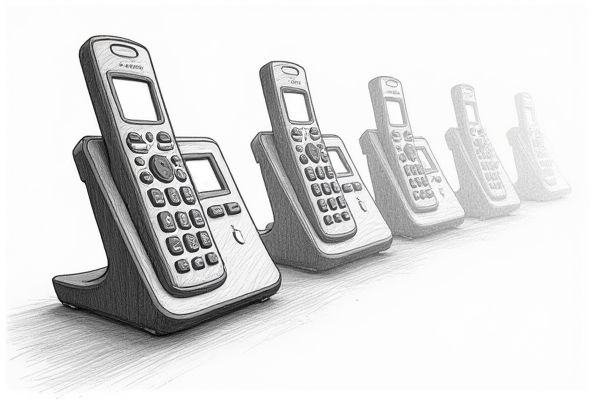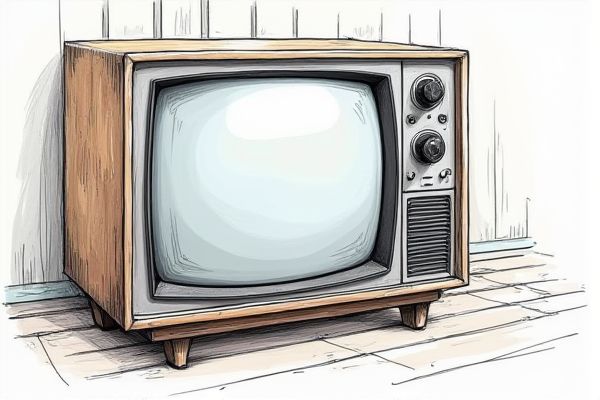In today's interconnected world, having a reliable and efficient telephone is more essential than ever. With an array of brands offering top-notch features, it can be overwhelming to choose the best one to fit your needs. From well-established names like Apple and Samsung to emerging challengers offering competitive alternatives, consumers have a plethora of options ensuring quality and innovation. To help you navigate through this multitude of choices, we've curated a list of the best telephone brands currently making waves in the market. Discover more about these leading brands below.

Illustration of telephone
Best brands of telephone in 2025
Apple
Apple has firmly established itself as a leading smartphone brand in the United States, with an impressive market share of approximately 61.3% as of 2024, marking a significant growth from 42.3% in 2014. This dominance is attributed to the high satisfaction and loyalty among iPhone users, with 92% expressing satisfaction and 48% unlikely to switch brands. Apple's iOS continues to hold the largest share of the smartphone operating systems market in the U.S., with over 135 million iPhone users in the country. The company's success is also reflected in its financial performance, becoming the first U.S. company to exceed a market capitalization of two trillion dollars. Apple's iPhones are preferred by many Americans, contributing to the company's steady growth trajectory. For more detailed information, you can visit the statistics on iPhone market share in the U.S.
Samsung
Samsung is one of the leading producers of smartphones globally, holding a significant market share. As of the third quarter of 2024, Samsung held 18.3% of the global smartphone market share, making it a consistent front-row competitor since 2009. In 2023, Samsung shipped around 226.6 million smartphones worldwide and accounted for 19.4% of all smartphone shipments. The company's Galaxy series, first released in 2009, remains its main line of smartphone products. With over 1.033 billion users worldwide, Samsung's smartphone penetration is among the highest in the industry. For more detailed statistics, visit the global market share data.
Google's Pixel series has been gaining significant traction in the smartphone market, with the brand achieving a market share of around 12% in the US, driven largely by the success of the Pixel 9 series. This growth indicates Google's increasing popularity, especially with the Pixel 9 Pro being a top choice in 2024. Despite some fluctuations, Google's market share has shown a steady rise, with the third quarter of 2024 being its best quarter in terms of sales. Google's strong presence is also reflected in its global sales, with the company aiming to sell 10 million units annually. The Pixel series is well-received for its camera capabilities and integration with Google services. For an insightful analysis of this trend, you can read more about Google's surging Pixel sales.
Huawei
Huawei is a leading global telecommunications company, renowned for its innovative 5G technology and robust smartphone market presence. As of 2023, Huawei holds a 4% global smartphone market share and a significant 23.22% market share in China, although this has declined from the previous year. The company has over 197,000 employees and has invested heavily in R&D, with a total investment of CNY997.3 billion in 2022. Huawei's HarmonyOS has been deployed on 330 million devices, and the company leads in the global 400G WDM market with a 35% market share as of the first quarter of 2022. Despite facing international restrictions, Huawei remains a dominant player in the telecommunications sector.
Xiaomi
Xiaomi has solidified its position as one of the leading smartphone brands globally, achieving a market share of 11.9% in January 2024 and becoming the third-largest smartphone brand worldwide. In 2023, Xiaomi generated $37.47 billion in revenue and shipped 145.6 million smartphones, with a significant presence in Asia, where it accounted for 14% of the market share in Q1 of 2024. The company also saw a 23% increase in global shipments to 40.7 million handsets in the last quarter of 2023. Xiaomi's MIUI user base reached around 606 million globally as of June 2023, and the brand's smart TV shipments exceeded 66 million units. With a strong presence in over 100 countries, Xiaomi continues to expand its market dominance.
OnePlus
OnePlus, founded in 2013, has established itself as a significant player in the global smartphone market, particularly in the premium segment. The brand is known for its "Never Settle" mantra, focusing on user-centric technology and affordable flagship devices. In Western European markets, OnePlus has seen considerable growth, ranking as the third best-selling premium smartphone in Sweden and fourth in the UK, France, Germany, and the Netherlands in Q2. This success is attributed to its ability to offer flagship-grade specs at competitive price points, typically between $500-$600. OnePlus continues to expand its market share, challenging industry conventions and providing a strong alternative to other premium brands. For more insights into their brand philosophy and offerings, visit their official OnePlus page.
Sony
Sony, despite facing challenges in the smartphone market, remains a notable player with a 3.5% global market share in the first half of 2024, selling approximately 6 million smartphones worldwide. The company's Xperia series, particularly the Xperia 1 V, has garnered attention for its high-end features such as the Snapdragon 8 Gen 3 processor and a 48MP quad-camera system. However, Sony's mobile sales have dropped significantly, with a 40% decline in 2023 compared to the previous year. The company is shifting its strategy to target a more mainstream audience with upcoming models. Sony's commitment to cutting-edge technology and sustainability initiatives continues to be a strong aspect of its brand. Discover more about Sony's Xperia smartphones.
Nokia
Nokia, a Finnish multinational telecommunications company, has established itself as a leading producer of telephone and network infrastructure equipment. As of 2023, Nokia holds the second-highest market share in the telecom network industry, with a 14.6% share, and generated a network infrastructure revenue of 8.04 billion euros. The company has transitioned from being a dominant mobile handset manufacturer to a significant provider of telecommunication network equipment and services, with a revenue of 22.26 billion euros in 2023. Nokia's focus on research and development has been crucial, with R&D expenses reaching 11.2% of its net sales in 2005. The company supports over 6.4 billion subscriptions with its radio networks and has deployed over 1,300 industrial networks worldwide. For more details, read about their new strategy and operating model.
LG
LG, once a leading smartphone brand, was known for its innovative features and unique designs, capturing a peak market share of 4.32% in August 2016. The brand introduced industry-firsts such as the ultra-wide camera and modular smartphone design. Despite its early success, LG's market share declined to 1.96% by 2020 and eventually led to the company's exit from the smartphone market in April 2021. LG's devices were praised for their stylish designs and cutting-edge technology, including collaborations with brands like Prada. However, the brand struggled to regain its footing against competitors like Apple and Samsung. For a deeper insight into their fall, visit this analysis of LG's smartphone division.
Motorola
Motorola is a renowned brand in the telecommunications industry, known for its innovative contributions since its founding in 1928. As of July 2024, Motorola holds a 3.99% market share in the US smartphone market, with plans to double its smartphone sales volume and target a 5% market share globally. The company has a rich history of pioneering mobile communications, including the introduction of the first commercial handheld cellular phone in 1983 and the world's first handheld public safety LTE device in 2012. Motorola's recent success is driven by its prepaid performance, particularly with the Moto G Play 2024, which contributed to a 21% year-over-year increase in market share. The brand continues to innovate, with a strong focus on premiumization and expanding its global presence.
















Leave a Reply
Your email address will not be published.